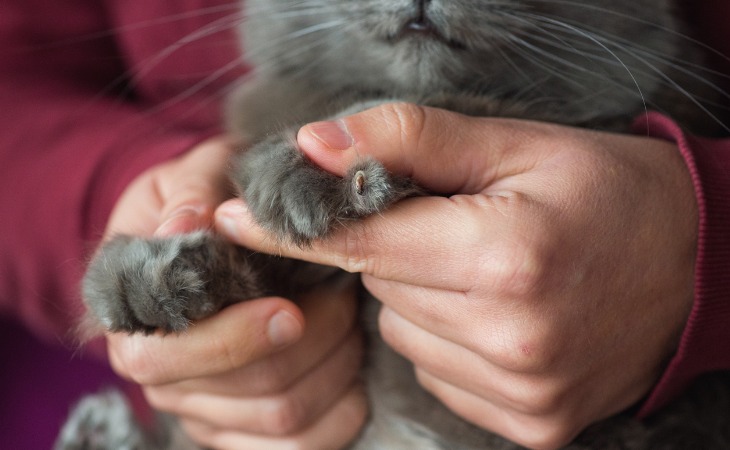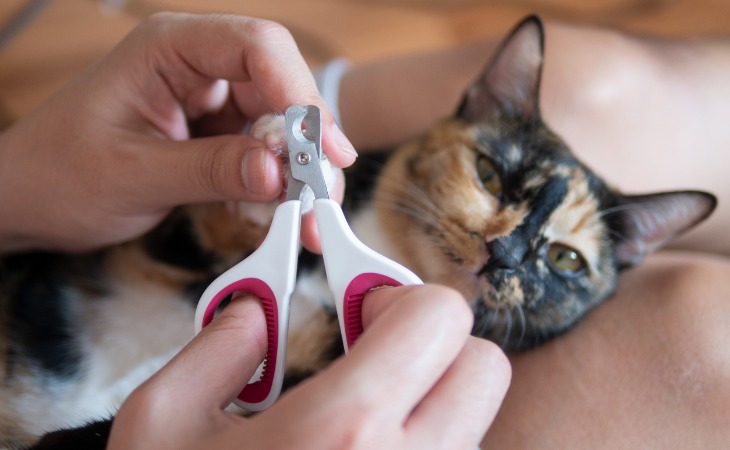Just as humans need to cut their nails to keep them from getting too long and unmanageable, cats need to have their claws trimmed from time to time. With that being said, having their claws trimmed is not always a pleasant experience for them.
When a cat’s claws are too long, it can be a nuisance for them. In addition, if their claws are not trimmed regularaly, your cat could ruin your furniture, tear holes in your clothes, or even hurt you with their claws unintentionally.
Trimming a cat’s claws only takes a few minutes and the more regularly your cat is subjected to it, the more they will accept it.
But how do you know if your cat needs their claws trimmed? How do you trim their claws and how often? Here’s everything you need to know to trim your cat’s claws!
When and why should I trim my cat’s claws?
There are several factors that determine whether or not a cat needs to have their claws trimmed. You need to take into account their lifestyle, the length of the claw or possible health problems.
Is your cat an indoor or outdoor cat?
Outdoor cats do not necessarily need to have their claws trimmed. This is because they are able keep their claws from getting too long by scratching tree trunks and by walking, jumping, and scratching the ground. With that being said, they also need their claws to be long enough to carry out their outdoor activities, such as climbing. It’s also useful when it comes to defending themselves against other animals they meet outdoors.
However, indoor cats need to have their claws trimmed regularly. It is important to provide your cat with a cat tree or scratching post so that they can shorten their claws as well. While scratching posts help, it isn’t enough to keep their claws from getting too long. Unlike outdoor cats who use their claws regularly outdoors, indoor cats wear them out less often. Their claws will grow and become too long, which will be a nuisance both for them and for you, as they may scratch you or ruin your belongings.
Claw length
There is not really an ideal claw length for all cats. It usually depends on their size and the size of their paws. You will quickly see when their claws are starting to become too long. In general, when your cat’s claws touch the floor at rest and make a clicking sounds on your floors, it’s time for a feline manicure. If you don’t intervene, your cat could slip or slide very easily while running. For an indoor cat, you can trim the nails every 6 to 8 weeks and make sure that their claws are just above the floor level when they put their paws down.
For outdoor cats, you may not need to trim their claws for most of their life. As they get older, however, they will become much less active. You’ll notice your cat having longer claws by the time they reach around 10 years old.
In addition, it’s important to be attentive as the seasons change. For example, in the winter, their claws might get too long in the winter and because it is cold, they might not want to go outside as much. Conversely, in the summer, when the temperature is nice, they might stroll and hunt outside much more often. In cases like this, you might only have to trim your cat’s claws in the winter.
Problems related to long claws
It’s important to keep an eye on your cat’s claw length, as excessively long claws can lead to many problems for your cat. A cat’s claws are naturally curved, which means that they curl towards the pad. If their claws are too long and continue to grow, it may become difficult for them to walk and run. In order to walk comfortably, they might try leaning differently on their limbs in an unnatural way, which can cause bone deformations and intense pain.
When claws are overly long, in extreme cases, it can even cause your cat to injure themselves. The claws can curl up to the point of entering the paw pads and the flesh, causing wounds followed by infections. Through gromming their fur, they will also pick up bad bacteria that they will then spread on to their wounds by licking them. In less extreme cases, your cat may scratch themselves. Infections in injured cats are not uncommon, even in small wounds.
How to trim your cat’s claws
Trimming your cat’s claws requires skill and certain accessories.
You will need
You should not use a pair of scissors or nail clippers made for humans. To trim your cat’s claws, you will need a nail clipper designed specifically for cats. These kind of nail clippers work a bit like scissors, except the inside of the blades are rounded with beveled edges, so they grip the cat’s claw and cut it cleanly.
Like scissors, claw trimmers have two handles that can be closed together to cut. The handle is wide and non-slip, as your cat may tend to move when it feels the pressure on their claw. The blades are made of stainless steel to avoid contamination from rust or bacteria.
The direction of the cut of the cat’s claws
Most cat have 18 claws: four claws on their back legs and five claws on each of their front legs. The front paws have more claws because they have a sort of thumb on the inner part of the paw, slightly set back from the other four toes, which is the dewclaw. When you trim your cat’s claws, you will have to cut all of them, if possible of equal length, so as not to cause any imbalance or discomfort to your cat. Cat claws are made up of an empty part (the tip) and a full part (the pinkish part, flesh). The claw should be cut before the pink part, just after the hollow formed by the claw.
There are two ways to trim a cat’s claws. The first is the angled trim. To do this, you need to position the trimmer on top of the claw and cut it at an angle, with the tip of the trimmer positioned towards the cat. This allows you to keep the sharpness and pointed effect of the claw. The angled cut is suitable for the outdoor cat. The second way to trim the claw is the straight cut. Simply position the clipper parallel to the cat’s paw. To trim the claw, press on the top of your cat’s toes. It does not hurt them.

Tips for cats who hate getting their claws trimmed
Some cats will patiently accept a claw trim and sit quietly on your lap. However, other cats may be particularly stressed. Some even find it super uncomfortable. But rest assured! As long as you’re careful not to trim the pinkish tip of the claw, your cat won’t suffer.
The trick is not to show your cat the nail clippers, as they will anticipate the trim and may become stressed. Instead, wrap your cat up gently in a blanket so that they cannot bit or move their paws. Leave the tips of their paws outside of the blanket and lay your cat on their side. It’s best to speak softly to your cat. If your cat feels scared when they see what’s going on, you can create a sort of barrier in front of your cat’s head with the blanket. If you continue to trim your cat’s claws, after a few months, your cat will get used to it.
You can also check out this article: Why does my cat knead me?

